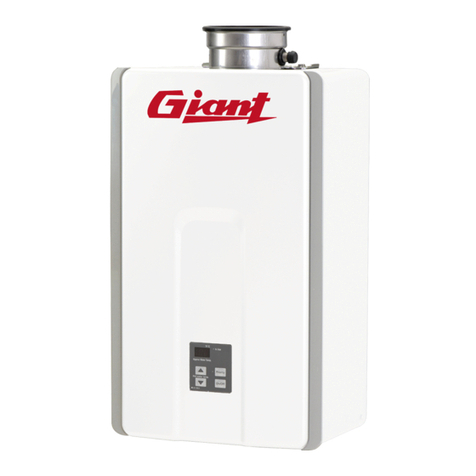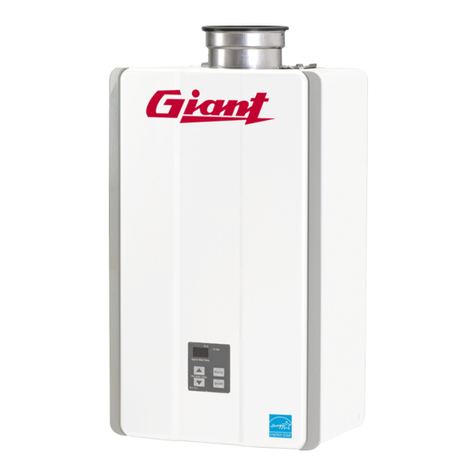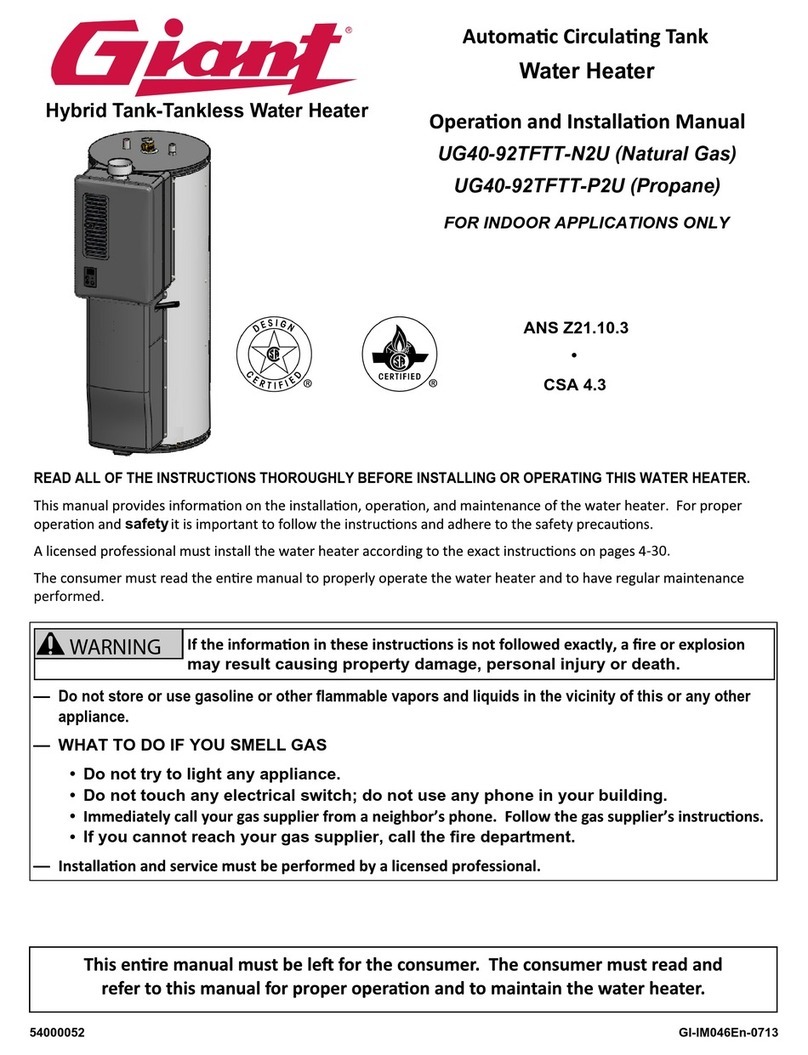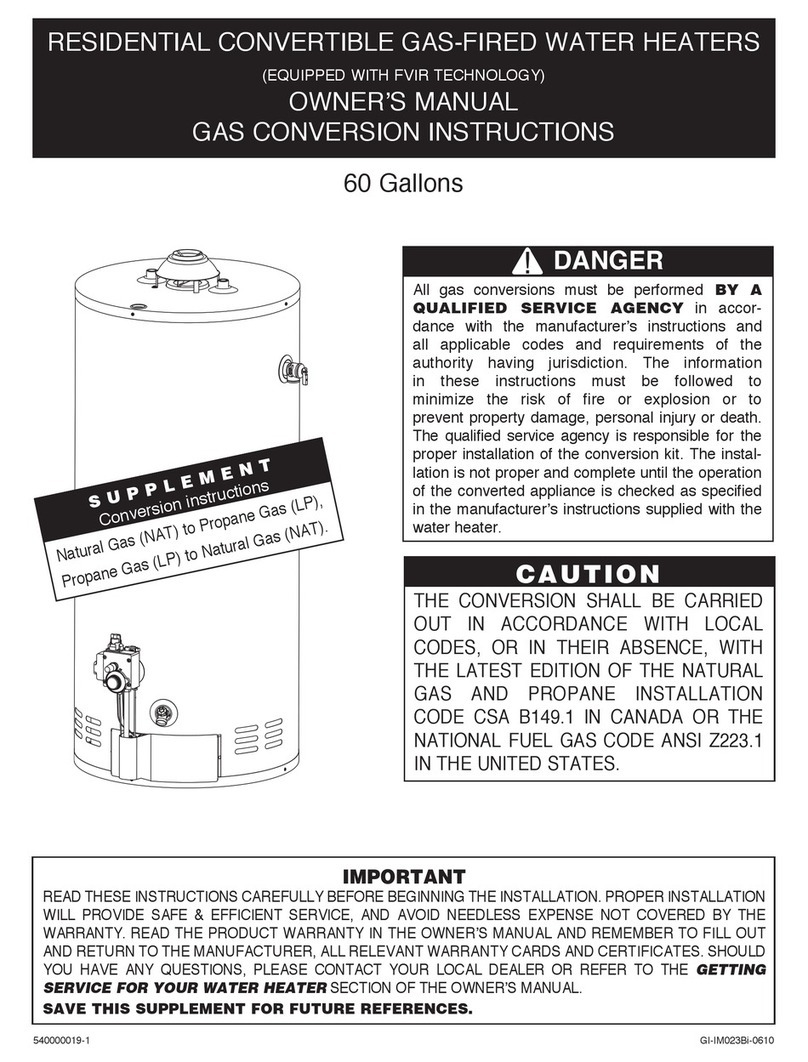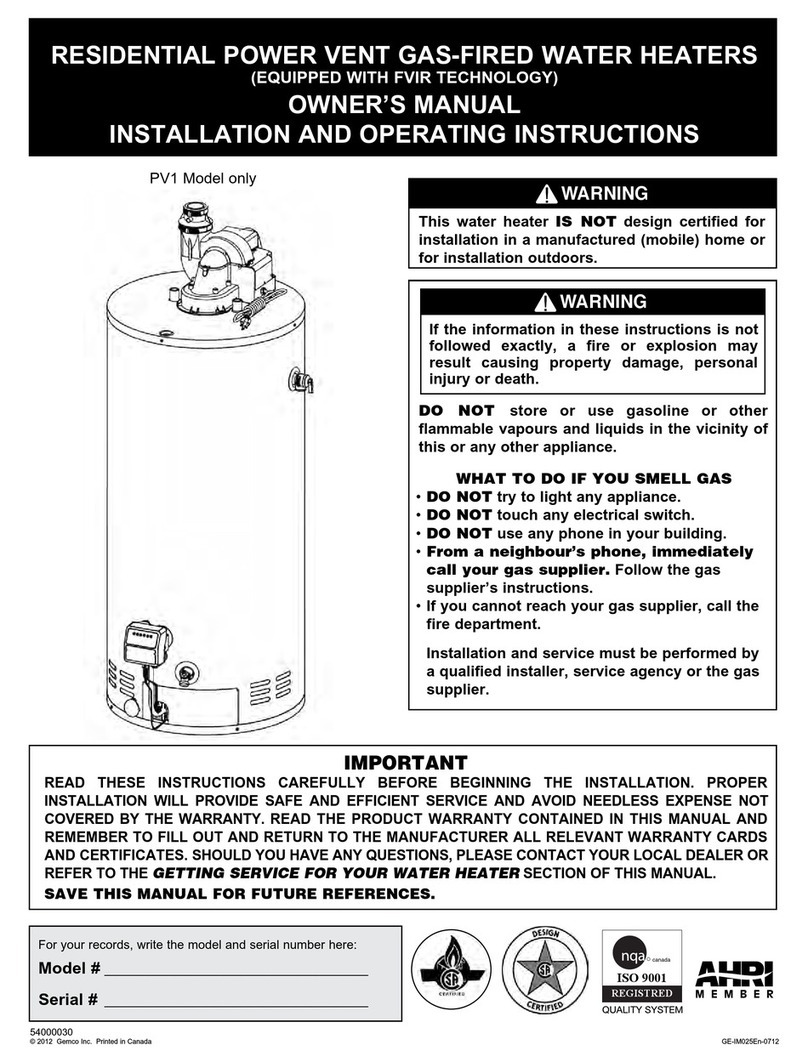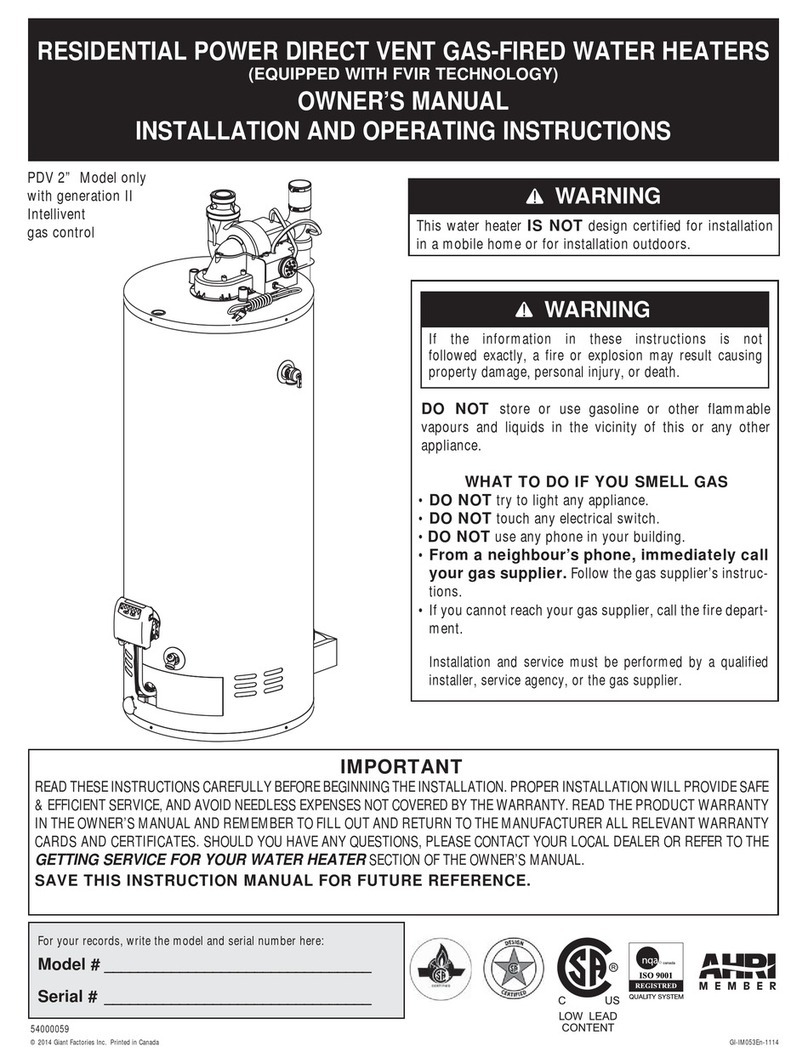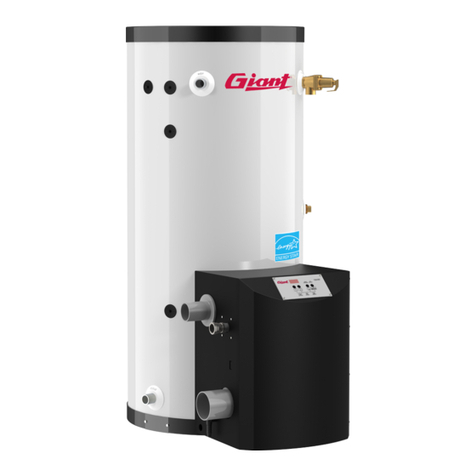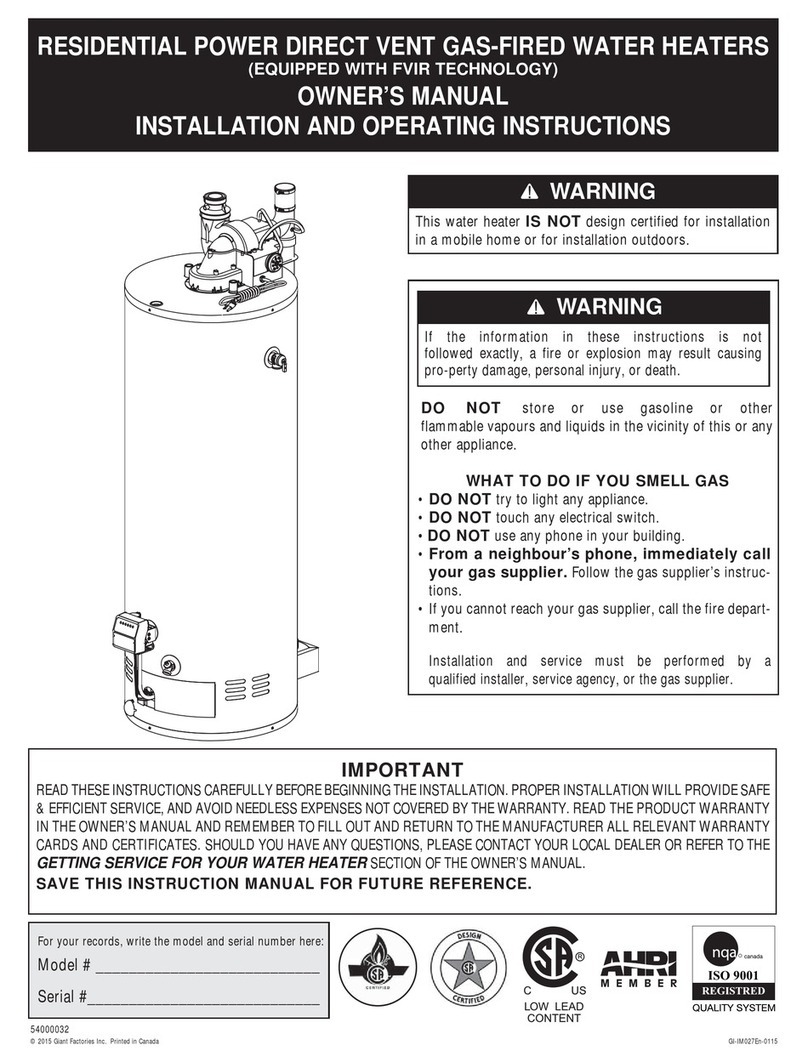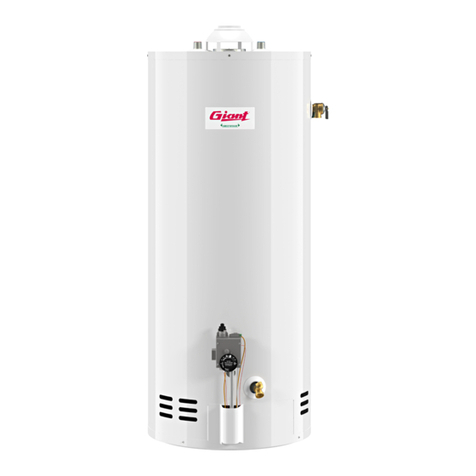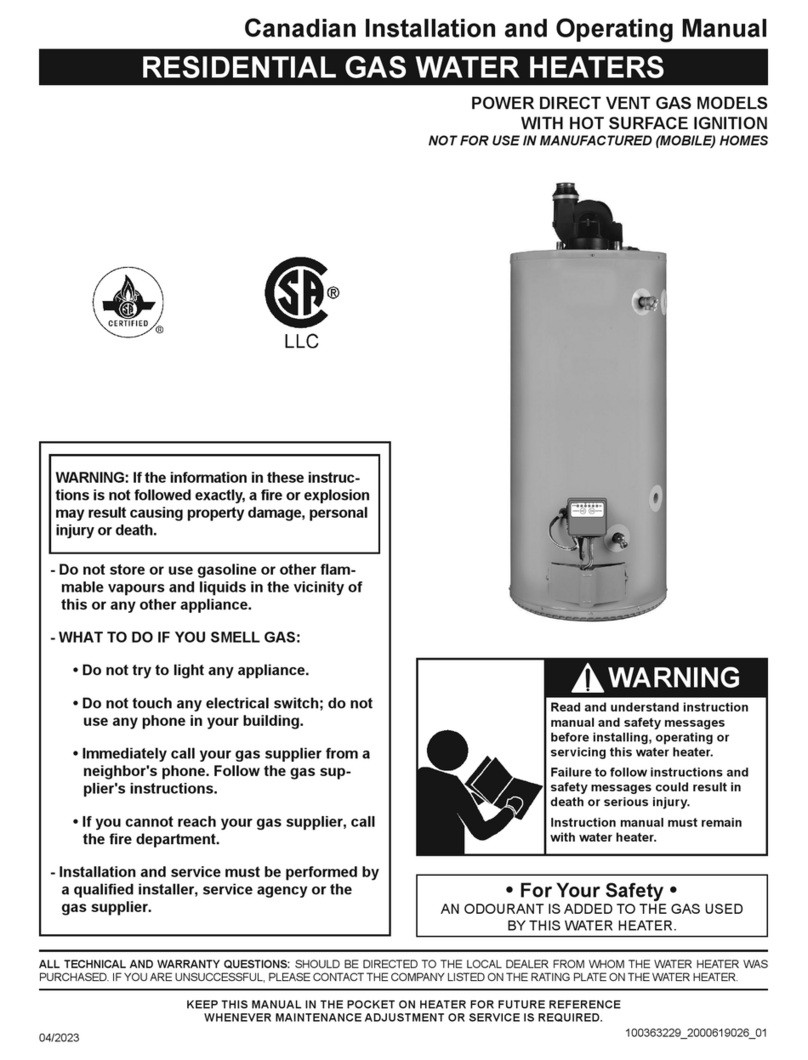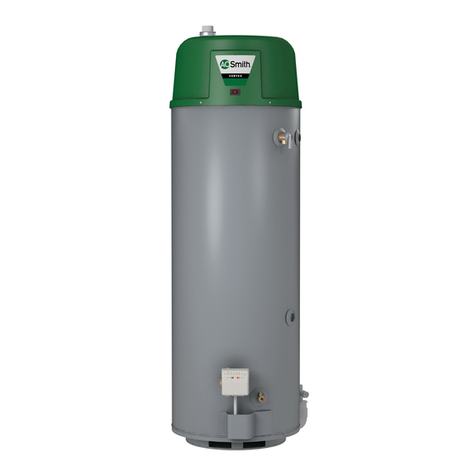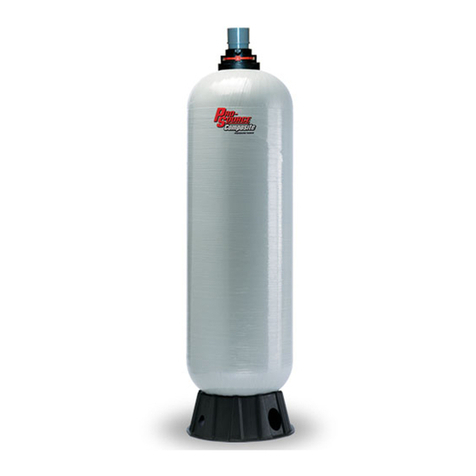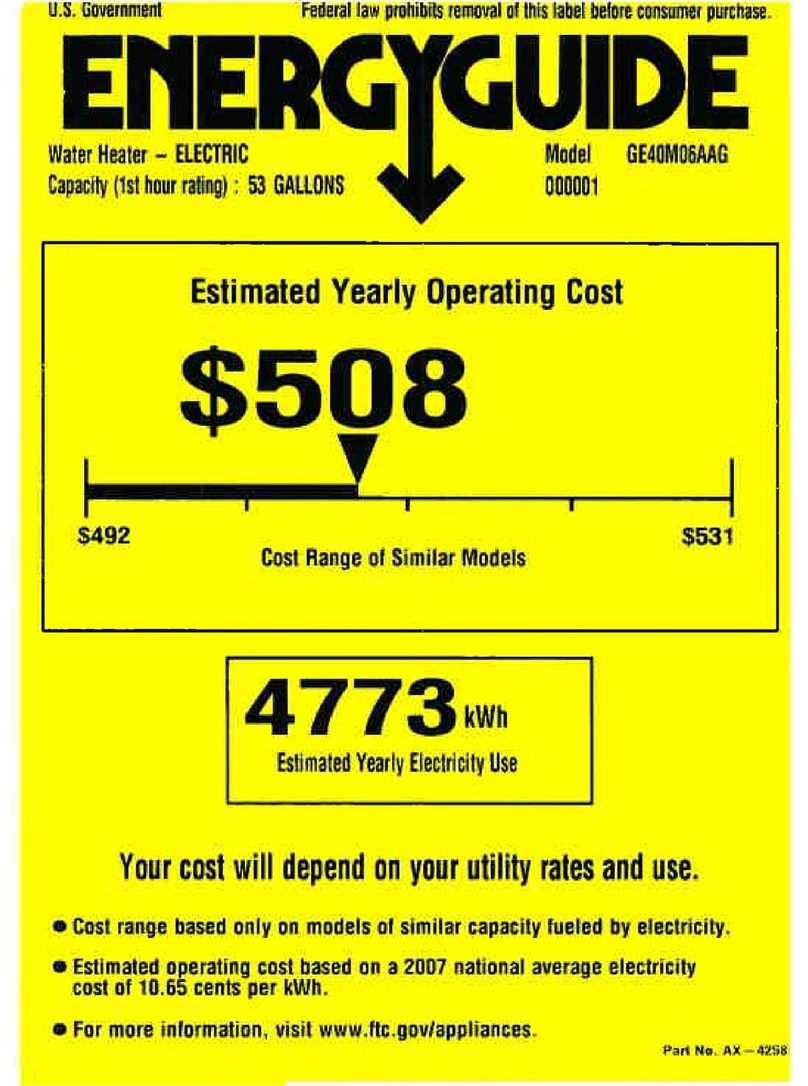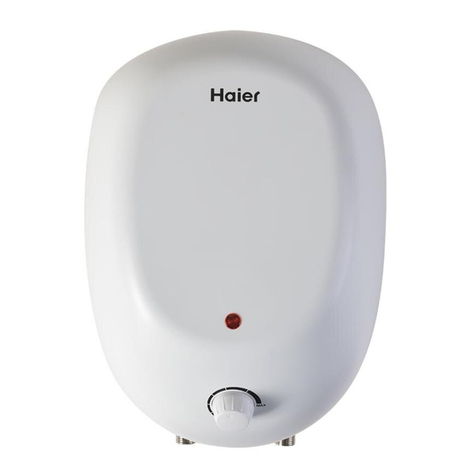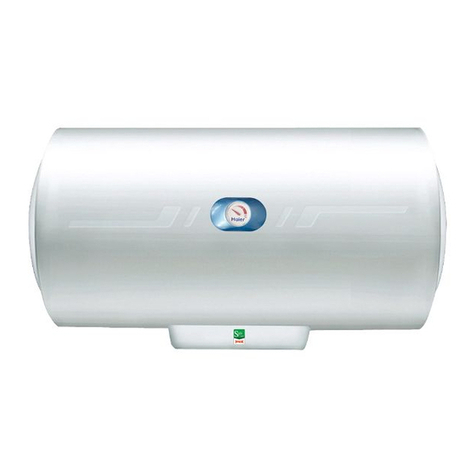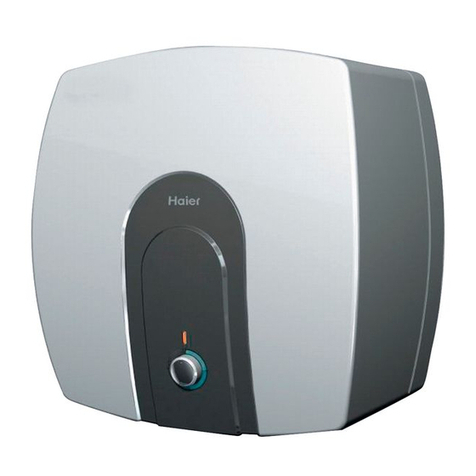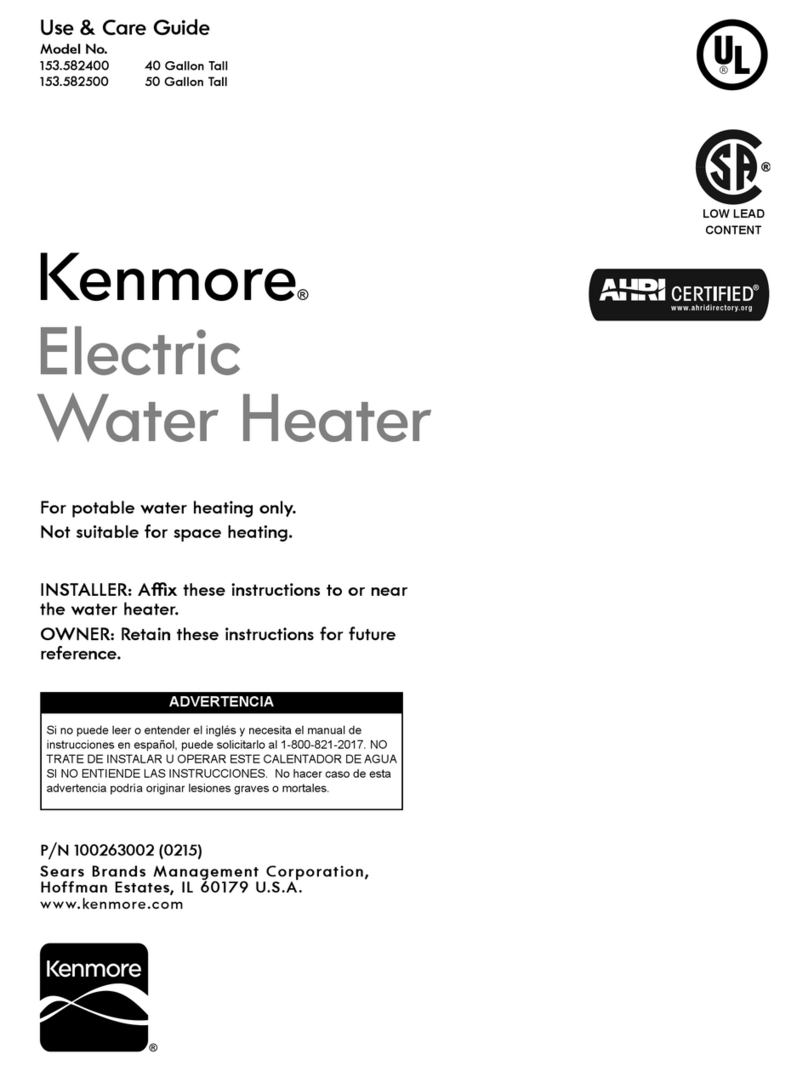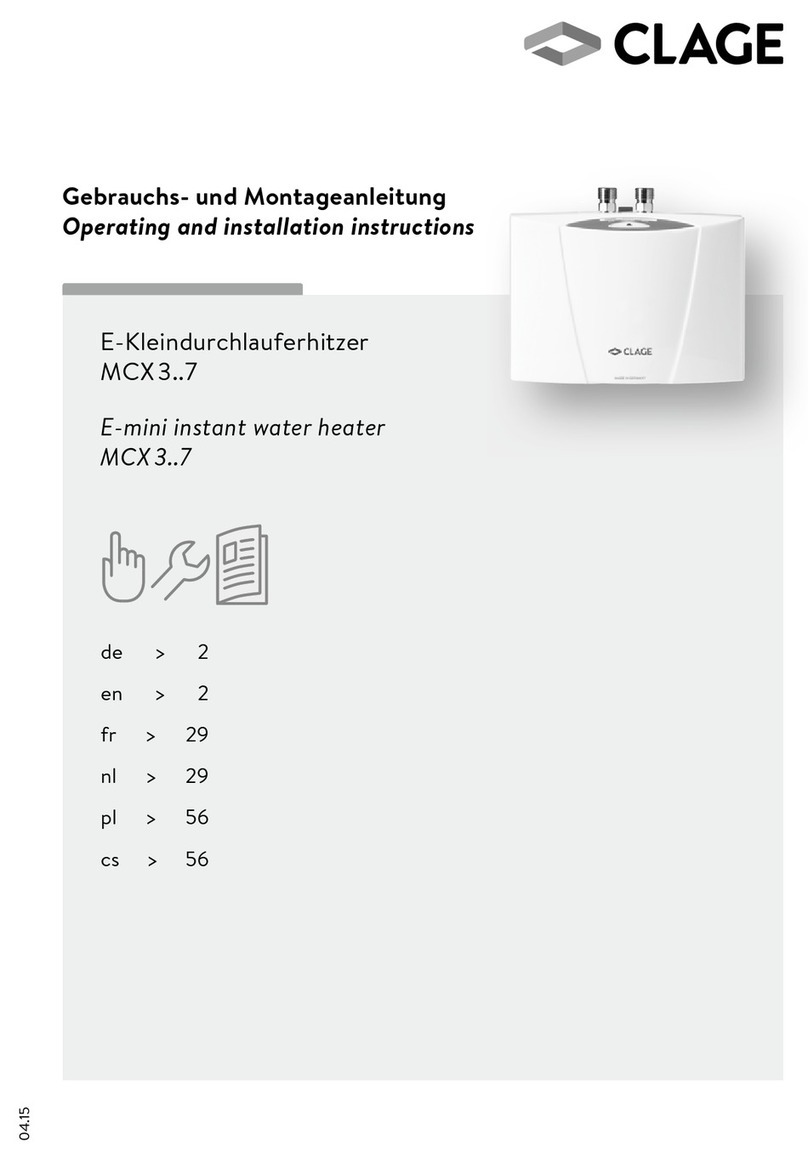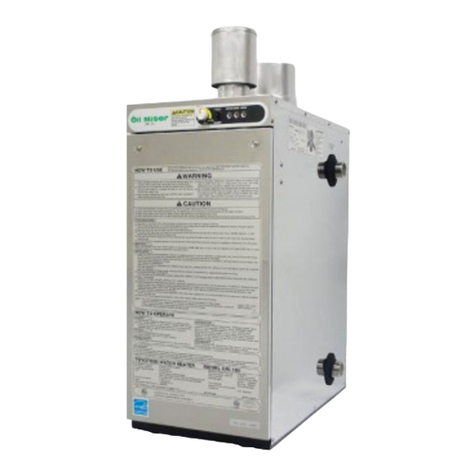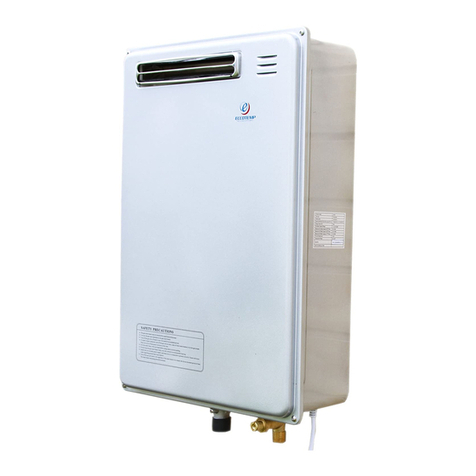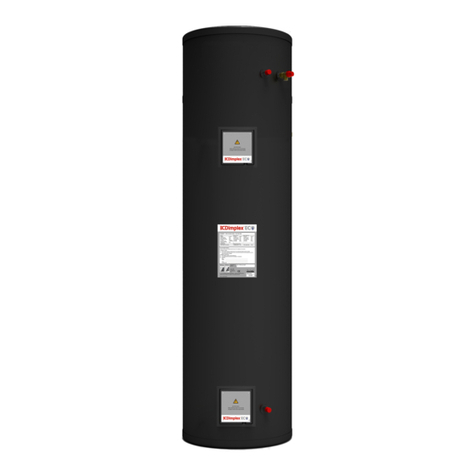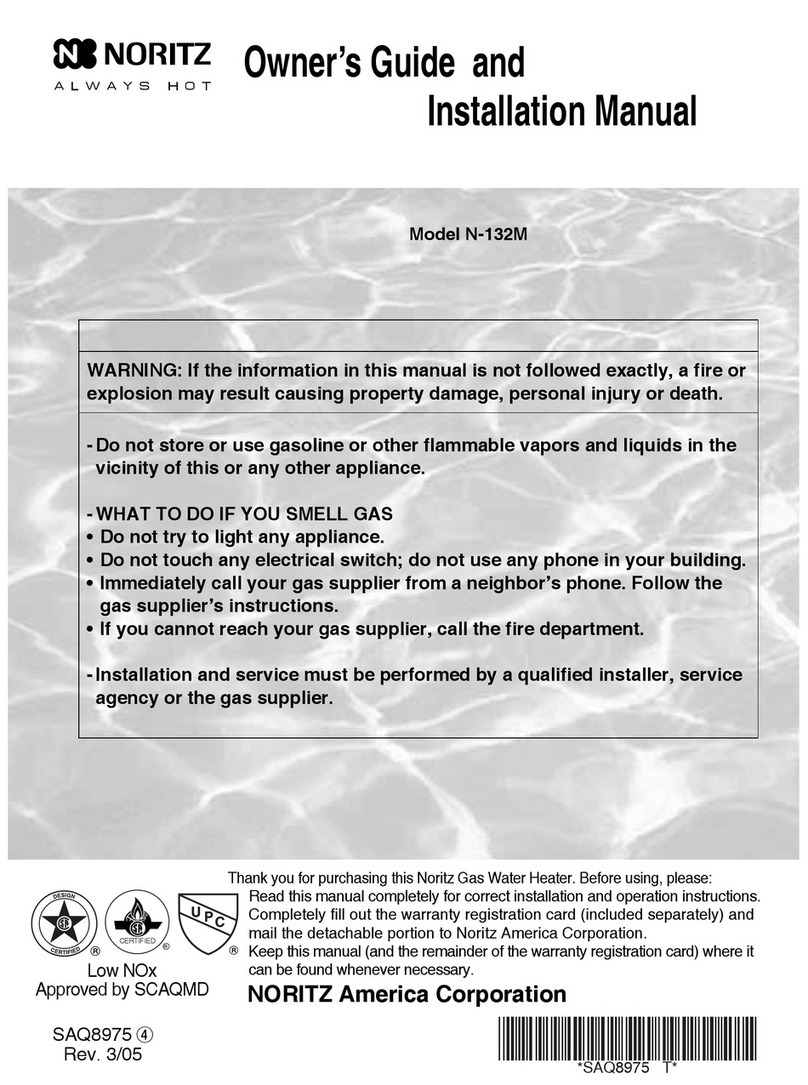
8
Insulation Blanket
This water heater meets or exceeds the National Appliance Energy
Conservation Act standards with respect to insulation and standby
losses. If an insulation blanket is still desired, the following proce-
dure must be followed.
a) Maintain an adequate distance from the vent.
b) Do not cover the front door of the tankless engine or the lower
enclosure of the assembly.
c) Do not cover the combustion air grill located on the front door
of the tankless engine.
d) Do not obstruct the operation of the pressure-relief valve.
e) Obtain new warning labels from the manufacturer to place on
the blanket, directly over the existing labels.
f) Frequently inspect the blanket to ensure the insulation blanket
has not been disturbed.
Checklist to Determine Installation Location
□The water heater is not exposed to corrosive compounds in
the air.
□The water heater location complies with the clearances stated
in the manual and on the label, located on the side of the unit.
□The area surrounding the water heater does not contain flam-
mable vapors that could ignite.
□The water supply does not contain chemicals or exceed total
hardness that will damage the heat exchanger.
□The water heater and its water lines are protected from freezing.
□A standard 3-prong 120 VAC, 60 Hz properly grounded wall
outlet or other properly grounded 120 VAC, 60 Hz source is
available.
□The installation must conform with local codes or, in the ab-
sence of local codes, with the National Fuel Gas Code, ANSI
Z223.1/NFPA 54, or the Natural Gas and Propane Installation
Code, CSA B149.1.
□Leave the entire manual taped to the water heater or give the
entire manual directly to the consumer.
Combustion Air Requirements
This water heater requires adequate combustion air for ventilation
and dilution of flue gases. Failure to provide adequate combustion
air can result in unit failure, fire, explosion, serious bodily injury, or
death. Use the following methods to ensure adequate combustion
air is available for correct and safe operation of this water heater.
Combustion air must be free of corrosive chemicals. Do not
provide combustion air from corrosive environments. Appli-
ance failure due to corrosive air is not covered by warranty.
IMPORTANT
Combustion air must be free of acid-forming chemicals, such as
sulfur, fluorine, and chlorine. These chemicals have been found to
cause rapid damage and decay and can become toxic when used
as combustion air in gas appliances. Such chemicals can be found
in, but not limited to, bleach, ammonia, cat litter, aerosol sprays,
cleaning solvents, varnish, paint, and air fresheners. Do not store
theseproducts orsimilar productsinthe vicinityof thiswater heater.
Unconfined Space
An unconfined space is defined in
National Fuel Gas Code, ANSI
Z223.1/NFPA 54
as “a space whose volume is not less than fif-
ty (50) cubic feet per 1,000 BTU/hr (4.8 m3per kW per hour) of
the aggregate input rating of all appliances installed in that space.
Rooms communicating directly with the space in which the appli-
ances are installed, through openings not furnished with doors,
are considered a part of the unconfined space.” If the “unconfined
space” containing the appliance(s) is in a building with tight con-
struction, additional outside air may be required for proper op-
eration. Outside air openings should be sized the same as for a
confined space.
Figure 3
Note: plafond de
8 pi (2,4m)
Note: plafond de
8 pi (2,4m)
35 pi (10,6m)
35 pi
(10,6m)
25 pi (7,6m)
25 pi
(7,6m)
Note: 8 FT (2.4 m)
ceiling Note: 8 FT (2.4 m)
ceiling
35 FT
(10.6 m)
25 FT
(7.6 m)
Unconfined Space
91,300 BTU Water Heater and
a 100,000 BTU Furnace
Confined Space
Confined Space
(Small Room, Closet, Alcove, Utility Room, Etc.)
A confined space is defined in the
National Fuel Gas Code, ANSI
Z223.1/NFPA 54
as “a space whose volume is less than fifty (50)
cubic feet per 1,000 BTU/hr (4.8 m3per kW per hour) of the ag-
gregate input rating of all appliances installed in that space.” A
confined space must have two combustion air openings. Size the
combustion air openings based on the BTU input for all gas utiliza-
tion equipment in the space and the method by which combustion
air is supplied:
Louvers and Grilles
When sizing the permanent opening as illustrated in
Figure 5
,
consideration must be taken for the design of the louvers or
grilles to maintain the required free area required for all gas utiliz-
ing equipment in the space. If the free area of the louver or grille
design is not available, assume wood louvers will have 25% free
area and metal louvers or grilles will have 75% free area. Under no
circumstance should the louver, grille, or screen have openings
smaller than ¼” (6 mm).
Example:
Wood: 10 in. (25 cm) x 12 in. (30.5 cm) x 0.25 = 30 in2(193.5 cm2)
Metal: 10 in. (25 cm) x 12 in (30.5 cm) x 0.75 = 90 in2(580.6 cm2)
Location
To maintain proper circulation of combustion air, two permanent
openings (one upper, one lower) must be positioned in confined
spaces. The upper shall be within twelve (12) inches (30.5 cm) of
the confined space and the lower opening shall be within twelve
(12) inches (30.5 cm) of the bottom of the confined space. Open-
ings must be positioned as to never be obstructed.
INSTALLATION INSTRUCTIONSINSTALLATION INSTRUCTIONS



